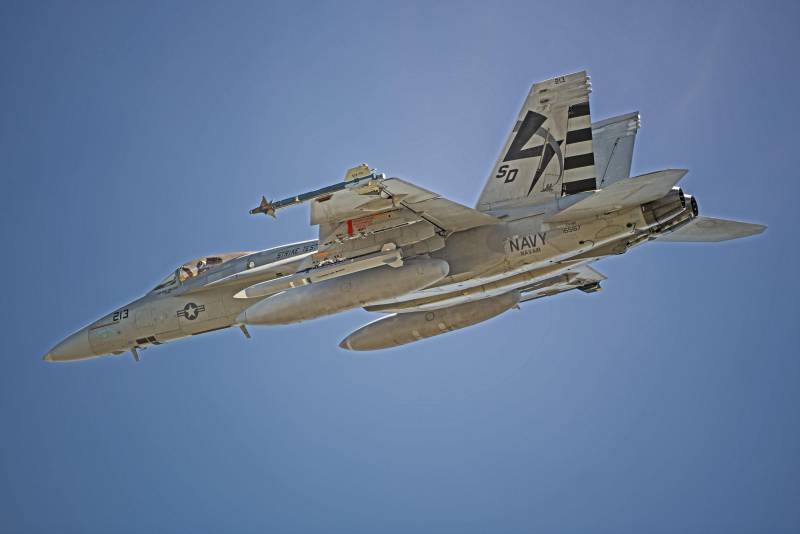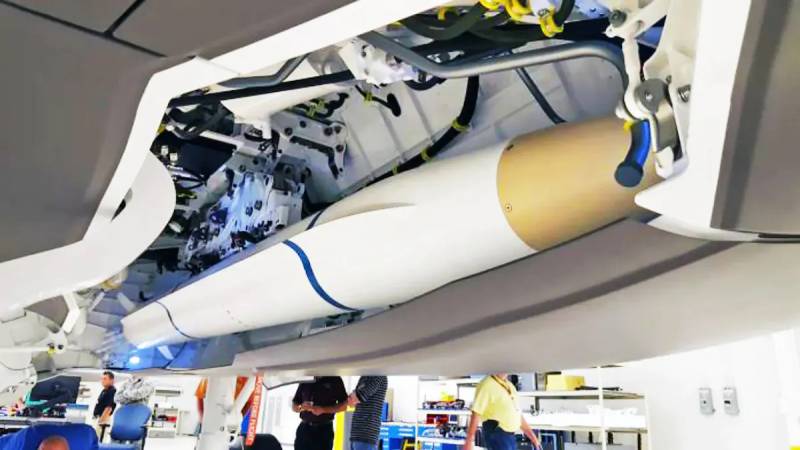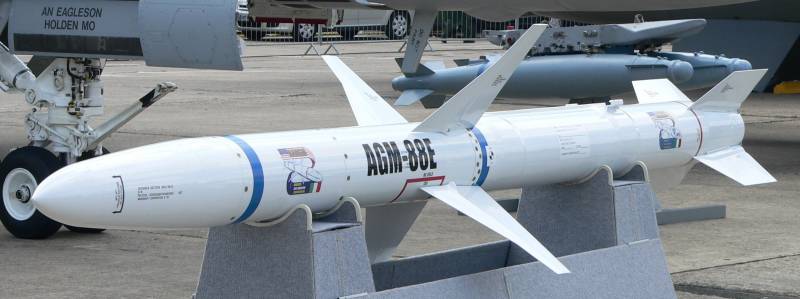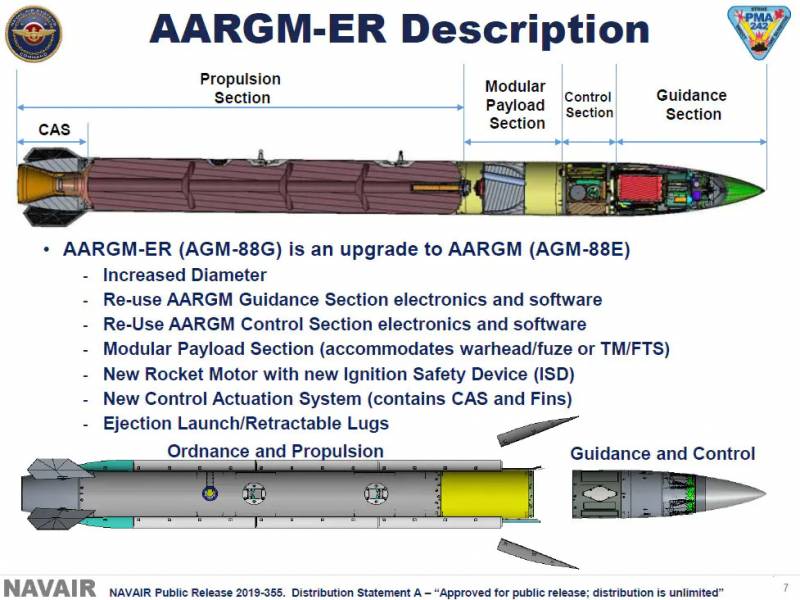New AGM-88G AARGM-ER Aircraft Missile for US Navy

The first take-off flight of the AGM-88G rocket. The prototype is suspended under the left wing, next to the PTB. Photo NAVAIR / navair.navy.mil
The US Navy continues to develop new aviation weapons of destruction for carrier-based aircraft. A few days ago, tests began on the promising AGM-88G AARGM-ER anti-radar missile, developed specifically for naval aviation. So far, we are talking only about the first export flights, but in a few years the missile will go into service - and can become a real threat to a potential enemy.
First flight
According to the Naval Air Systems Command (NAVAIR), tests of the AGM-88G Advanced Anti-Radiation Guided Missile - Extended Range began on June 1 at the Patuxent River training ground (Maryland). The first carrier of the experimental rocket was the carrier-based fighter F / A-18E from the 23rd test squadron (VX-23).
A plane with a payload in the form of two hanging tanks, a pair of air-to-air missiles and one prototype AGM-88G made a take-off, completed a series of maneuvers and landed. During such a flight, information was collected about the arising loads and the reaction of the rocket to them.
The command highly noted this flight, since it puts an end to the main part of the design work and gives start to flight tests. The information collected will be taken into account in the further development of the rocket, which will soon have to go to full flight tests. Tests and debugging will take the next few years. According to current plans, the AGM-88G will go into production and reach initial operational readiness in 2023.
New modification
The current AGM-88G AARGM-ER missile is another representative of a fairly old family dating back to the AGM-88 HARM. At the same time, it is being developed on the basis of the later AGM-88E AARGM and is most unified with it. In both cases, we are talking about a major restructuring of the original design, which appeared in the eighties.
Recall that the product AGM-88E was developed since 2005 by order of the Italian and US defense ministries. The project was done by Orbital ATK and Northrop Grumman. In 2012-13. two customers received the first batch of serial missiles and began their introduction in the troops. In 2019, another order appeared - Germany acquired the missiles.
In 2016, the U.S. Navy funded the start of work on a new modification of the anti-radar missile. The product AGM-88G AARGM-ER was supposed to repeat the existing AGM-88E as much as possible, but have improved flight performance, primarily range. The preliminary project competition ended with the victory of Orbital ATK. In January 2018, she received an appropriate contract.
The main customer for the AARGM-ER program is the naval forces wishing to rearm deck aircraft. Later, the US Air Force joined the program. They are interested in getting the AGM-88G for their F-35A fighters. However, the leading role remains fleet, and the Air Force actually only participate formally.
Technical features
Despite the high degree of unification with the AGM-88E, the new AGM-88G has a different layout and composition of equipment. The long-range missile is made in a cylindrical case with an increased diameter (290 mm versus 254 mm for its predecessors). On the outer surface there is a pair of side gargrot; of the planes only tail rudders remained. The layout has been slightly revised: the head compartment accommodates the homing head, the warhead is placed behind it, and the engine occupies all other volumes. Around the nozzle apparatus steering machines are arranged.
AARGM-ER retains the AARGM GOS, but instrument placement has been redesigned to accommodate a wider housing. There are satellite and inertial navigation devices, an autopilot, as well as a radar seeker with passive and active modes. Search for a target is carried out by its radio signals; At the end of the flight, active radar is turned on for a more accurate hit. The seeker is protected from interference and maintains operability when the monitored signal is lost.
On-board equipment is able to exchange data with the carrier, up to the moment it hits the target. In particular, this allows the aircraft to be informed of an imminent successful defeat - or miss.
A new modular warhead has been proposed for the AGM-88G, the exact parameters of which have not yet been named. The customer’s requirements included a multi-mode fuse that provides detonation when directly hit the target or when passing near it.
About half the body length is occupied by a new solid fuel engine. According to open data, it provides an increase in flight speed in comparison with the AGM-88E (maximum speed - 2M) and a twofold increase in range - up to 300 km.
AARGM-ER must be compatible with different media. The Navy plans to use it on F / A-18E / F fighters and on the EA-18G electronic warfare aircraft. Also, the new missile will be included in the ammunition of the land and deck modifications of the F-35 fighter. In this case, it is possible to transport and launch from internal cargo compartments. One aircraft can carry up to 2-4 missiles.
In the recent past, Northrop Grumman displayed a ground-based launcher for the AGM-88E / G as a standard shipping container. As far as we know, such a project has not yet been developed.
Long arm aviation
So far, the AGM-88G is in the early stages of testing, and the emergence of such weapons the troops are expected only in a few years. Apparently, all the necessary work will be completed on time. This is facilitated by the widespread use of finished components that no longer need to be developed.

The prototype AGM-88G in the cargo compartment of the F-35 fighter. Photo Orbital ATK / Northrop Grumman
In the future, along with a promising missile, the Navy and, possibly, the US Air Force will receive some new shock capabilities. The Navy is again waiting for an effective tool that can aim at these radiating targets or independently search for them. Some of the features and advantages of the new missile pose a danger to third countries and may become the reason for the adoption of certain measures.
An important advantage of the AGM-88G is the function of storing the coordinates of the detected target and the operation of the ARGSN in the final section of the flight, increasing the likelihood of a successful solution to the combat mission. Also, the product can transmit data about the target being attacked and the results of the attack. Thus, the rocket simultaneously turns out to be a means of destruction and a scout. According to her data, you can clarify the picture of the battlefield and the location of the enemy's emitting objects.
A serious cause for concern should be a new engine that dramatically improves flight performance. AGM-88G will be able to fly 300 km, which will move the launch line away from enemy positions. As a result of this, the enemy will have to use more long-range air defense systems that can detect, attack and hit the carrier aircraft in time to repel the attack in a timely manner. Otherwise, anti-aircraft systems will have to deal with a more complex target in the form of a rocket.
In general, the promising anti-radar missile AGM-88G AARGM-ER will become a convenient and effective aviation weapon. It combines the best modern developments on radar seeker and engines, which gives an advantageous combination of flight and combat characteristics.
Real threat
AGM-88G is created in the interests of the US Navy. Deck fighter-bomber and EW aircraft will be able to use it to destroy surface or coastal targets - ship and land radars for various purposes, including from the composition of air defense systems. Probable US adversaries need to take certain measures to protect against such weapons. In general, they repeat the already known methods of countering anti-radar missiles, but they need to be developed taking into account the characteristic features of AARGM-ER.
To effectively combat carrier aircraft and missiles of the AGM-88 family, a well-developed and layered air defense system is needed, capable of detecting targets at distances of hundreds of kilometers and hitting them at distances of at least 200-300 km, and if necessary, “shooting through” at medium or short ranges. For example, Russia has similar systems for the ground forces and the navy. They should be developed and strengthened by the country's air defense as a whole - and then the AGM-88G missile will lose its advantages by the time it begins operation.


Information